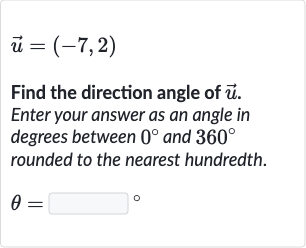Full solution
Q. Find the direction angle of . Enter your answer as an angle in degrees between and rounded to the nearest hundredth.
- Calculate Tangent Ratio: To find the direction angle of the vector , we need to calculate the angle that the vector makes with the positive x-axis. The direction angle can be found using the arctangent function, which is the inverse of the tangent function. The tangent of the direction angle is the ratio of the y-coordinate to the x-coordinate of the vector. However, since the x-coordinate is negative and the y-coordinate is positive, the vector lies in the second quadrant. The arctangent function will give us an angle in the fourth quadrant, so we need to add degrees to get the angle in the second quadrant.
- Find Arctangent Angle: First, calculate the tangent of the direction angle using the y-coordinate and the x-coordinate of the vector :.
- Adjust for Quadrant: Next, find the arctangent of the ratio to get the angle in degrees. Since most calculators return the angle in the range from to degrees, we will get an angle in the fourth quadrant:.
- Calculate Final Angle: Using a calculator, we find that:.Since this angle is in the fourth quadrant, we add degrees to find the angle in the second quadrant:.
- Calculate Final Angle: Using a calculator, we find that:.Since this angle is in the fourth quadrant, we add degrees to find the angle in the second quadrant:.Performing the addition, we get:.Now we round this to the nearest hundredth:.
More problems from Inverses of sin, cos, and tan: degrees
QuestionGet tutor help
QuestionGet tutor help
QuestionGet tutor help
QuestionGet tutor help
QuestionGet tutor help
QuestionGet tutor help
Question
. Find the value of in degrees.Write your answer in simplified, rationalized form. Do not round.____
Get tutor helpQuestionGet tutor help

